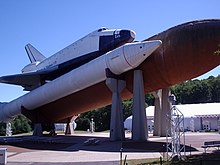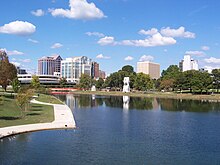Huntsville, Alabama
Huntsville, Alabama | |
|---|---|
From top, left to right: Downtown, Huntsville Museum of Art, United States Space and Rocket Center, EarlyWorks Children's Museum, Propst Arena, and the First National Bank | |
| Nickname: Rocket City[1] | |
| Motto: "Star of Alabama"[2] | |
 Interactive map of Huntsville | |
| Coordinates: 34°43′48″N 86°35′6″W / 34.73000°N 86.58500°W | |
| Country | |
| State | |
| Counties | Madison, Limestone, Morgan[3] |
| Established (as Twickenham) | December 23, 1809[4] |
| Incorporated (town) | December 9, 1811[5][6] |
| Incorporated (city) | February 24, 1860[7] |
| Founded by | LeRoy Pope |
| Named for | John Hunt |
| Government | |
| • Type | Mayor–Council |
| • Mayor | Tommy Battle (R) |
| • Council | Huntsville City Council |
| Area | |
| • City | 220.83 sq mi (571.95 km2) |
| • Land | 219.34 sq mi (568.08 km2) |
| • Water | 1.49 sq mi (3.87 km2) |
| Elevation | 581 ft (177 m) |
| Population | |
| • City | 215,006 |
| • Estimate (2023)[11] | 230,463 |
| • Rank | 100th in the United States 1st in Alabama |
| • Density | 980/sq mi (378.5/km2) |
| • Urban | 329,066 (US: 122nd) |
| • Urban density | 1,532.2/sq mi (591.6/km2) |
| • Metro | 491,723 (US: 108th) |
| Demonym | Huntsvillian |
| Time zone | UTC−6 (CST) |
| • Summer (DST) | UTC−5 (CDT) |
| ZIP codes | 35649, 35749, 35748, 35754, 35756, 35757, 35671, 35741, 35762, 35763, 35773, 35801–35816, 35824, 35893-35899, 35810 |
| Area codes | 256, 938 |
| FIPS code | 01-37000 |
| GNIS feature ID | 2404746[9] |
| Interstates | |
| U.S. Routes | |
| Website | City of Huntsville |
Huntsville is a city in the north of the U.S. state of Alabama. It is in Madison County. It extends west into Limestone county. Huntsville is the county seat of Madison County.[13] The 2020 census showed that Huntsville has a population of 215,006.[10] The Huntsville metropolitan area's population was 491,723 in 2020.[12]
Huntsville is both the largest city in Alabama by population, and the largest city in Alabama by area.
John Hunt first settled in Huntsville in 1805. The town was named Twickenham after Alexander Pope's home town at the request of Leroy Pope.[14] However, the town was renamed to "Huntsville" on November 25, 1811. It has grown across nearby hills and along the Tennessee River. It has textile mills and also munitions factories. Also in this city are NASA's Marshall Space Flight Center and the United States Army Aviation and Missile Command at the Redstone Arsenal. The National Trust for Historic Preservation named Huntsville to its "America's Dozen Distinctive Destinations for 2010" list.[15]
History
[change | change source]First settlers
[change | change source]Huntsville is named after John Hunt. He was the first settler of the land around the Big Spring Park. However, Hunt did not correctly register his claim. The area was purchased by Leroy Pope, who named it Twickenham honour the home village of his kinsman Alexander Pope.
Twickenham was carefully planned. The streets were built from the northeast to southwest direction based on the Big Spring (see images below). However, due to anti-English feeling during the War of 1812, the town name was changed to Huntsville to honour John Hunt, who had been forced to move to other land south of the new city.
Both John Hunt and Leroy Pope were Freemasons and charter members of Helion Lodge.[16]
Incorporation 1811
[change | change source]In 1811, Huntsville became the first official town in Alabama. However, the recognized "birth" year of the city is 1805. This was the year of John Hunt's arrival. The city's sesquicentennial anniversary was held in 1955 and the bicentennial was celebrated in 2005.
Emerging industries
[change | change source]Huntsville's quick growth was generated by the cotton and railroad industries. Many rich planters moved to the area from Virginia, Georgia and the Carolinas. The forty-four delegates who met in Huntsville wrote a constitution for the new state of Alabama. The new state constitution said that Huntsville is Alabama's first capital. This was temporary for one legislative session only. The capital was then moved to another temporary location, Cahawba, until the legislature selected Montgomery as the permanent location.
In 1855, the Memphis and Charleston Railroad was built through Huntsville. It became the first railway to link the Atlantic coast with the lower Mississippi River.
Civil War
[change | change source]
Huntsville firstly opposed secession from the Union in 1861, but provided many men for the state's defense. The 4th Alabama Infantry Regiment, led by Col. Egbert J. Jones of Huntsville, fought at the Battle of Manassas. It was the first major battle of the American Civil War. The Fourth Alabama Infantry, which contained two Huntsville companies, were the first Alabama troops to fight in the war. Eight generals of the war were born in or near Huntsville.

After the Civil War
[change | change source]After the Civil War, Huntsville became a center for cotton textile mills, such as Lincoln, Dallas and Merrimack. Each mill had its own housing community. It included everything the mill workers needed (schools, churches, grocery stores, theatres, and hardware stores, all within walking distance of the mill).
Great Depression 1930s
[change | change source]During the 1930s, industry decreased in Huntsville because of the Great Depression. Huntsville became known as the Watercress Capital of the World[17] because of its harvest in the area. Madison County produced most cotton in Alabama during this time.[17]
World War II
[change | change source]By 1940, Huntsville was still a small quiet town with a population of only 13,150 inhabitants. This quickly changed with the beginning of World War II. Huntsville was chosen as the location of Huntsville Arsenal, with chemical and munitions manufacturing plants.[18] The Arsenal was almost closed in 1949 when it was no longer needed,[19] but it saw new life when Major General Holger Toftoy with support from Senator John Sparkman convinced the U.S. Army to choose Huntsville as the location for its missile research program. In 1950, General Toftoy brought German rocket scientist Wernher von Braun and his team to Redstone Arsenal to develop what would eventually become the United States' space program.[20]
Space flight
[change | change source]
On September 8, 1960, U.S. President Dwight D. Eisenhower formally dedicated the Marshall Space Flight Center in Huntsville.
The city's nickname is "The Rocket City" for its close history with U.S. space missions. Huntsville has been important in developing space technology. Since the 1950s, when the German scientists headed by Wernher von Braun, brought to the United States at the end of World War II through Operation Paperclip, managed to develop rockets for the U.S. Army. Their work included designing a rocket, that carried the first U.S. satellite and astronauts into space.[21]

The Saturn V, used by the Apollo program manned Moon missions, was developed at Marshall Space Flight Center. Huntsville continues to play an important role in the United States' Space Shuttle and International Space Station programs.
Huntsville's economy was nearly crippled and growth came to a near standstill in the 1970s following the closure of the Apollo program. The emergence of the Space Shuttle and the ever-expanding field of missile defense in the 1980s helped give Huntsville a resurgence that has continued into the 21st century.

References
[change | change source]- ↑ "ROCKET CITY, U.S.A." Time. p. 1. Archived from the original on August 31, 2008. Retrieved December 23, 2022.
- ↑ "Logo and Identity Standards". City of Huntsville. Retrieved December 23, 2022.
- ↑ Jordan, Michelle (February 23, 2018). "City Limits: Explaining the annexation process". City of Huntsville. Retrieved December 24, 2022.
- ↑ A Digest of the Laws of the State of Alabama: Containing The Statutes and Resolutions in Force at the end of the General Assembly in January 1823. Published by Ginn & Curtis, J. & J. Harper, Printers, New-York, 1828. Title 14. Chapter I. Section 2. pp. 106–107. "An Act directing Courts to be held in the County of Madison, &c.—Passed December 23, 1809(...)Sec 2. And be it further enacted. That the town so laid out shall be known by the name Twickenham." (Google Books)
- ↑ A Digest of the Laws of the State of Alabama: Containing The Statutes and Resolutions in Force at the end of the General Assembly in January 1823. Published by Ginn & Curtis, J. & J. Harper, Printers, New-York, 1828. Title 62. Chapter V. pp. 774–775. "An Act to Incorporate the Town of Huntsville, Madison County —Passed December 9, 1811." (Google Books)
- ↑ "62 – Chapter V.". A Digest of the Laws of the State of Alabama: Containing The Statutes and Resolutions in Force at the end of the General Assembly in January, 1823. New-York: Ginn & Curtis, J. & J. Harper, Printers. 1828. pp. 774–775.
- ↑ Acklen, William, ed. (1861). The Code of Ordnances of the City of Hunstville, With the Charter, Pursuant to an Order of the Mayor and Aldermen. Huntsville, Ala.: William B. Figures, Printer. Retrieved June 25, 2015.
- ↑ "2021 U.S. Gazetteer Files". United States Census Bureau. Retrieved March 31, 2022.
- ↑ 9.0 9.1 U.S. Geological Survey Geographic Names Information System: Huntsville, Alabama
- ↑ 10.0 10.1 "QuickFacts: Huntsville city, Alabama". United States Census Bureau. Retrieved September 2, 2023.
- ↑ "City and Town Population Totals: 2020-2021". United States Census Bureau. May 29, 2022. Retrieved May 30, 2022.
- ↑ 12.0 12.1 "2020 Population and Housing State Data". United States Census Bureau. Retrieved October 24, 2021.
- ↑ "Find a County". National Association of Counties. Retrieved 2008-01-31.
- ↑ "Notes on the History of Huntsville". Archived from the original on 2010-05-27. Retrieved 2010-08-03.
- ↑ Storey, Deborah (February 3, 2010). "Huntsville on the list of 'Distinctive Destinations' for 2010". The Huntsville Times.
- ↑ Helion Lodge #1, Huntsville, Alabama
- ↑ 17.0 17.1 "NASA MSFC Notes on the History of Huntsville". Archived from the original on 2010-05-27. Retrieved 2010-08-03.
- ↑ Hughes, Dr. Kaylene. Redstone Arsenal Complex Chronology: The Pre-Missile Era, 1941 Archived 2007-08-14 at the Wayback Machine. Redstone.army.mil
- ↑ Redstone Arsenal Complex Chronology: The Pre-Missile Era, 1949 Archived 2009-01-03 at the Wayback Machine. Redstone.army.mil
- ↑ "Biography of Wernher Von Braun". history.msfc.nasa.gov. Archived from the original on September 22, 2013. Retrieved August 3, 2010.
- ↑ "Huntsville, Alabama". huntsvilleal.gov. Archived from the original on September 29, 2010. Retrieved August 3, 2010.









